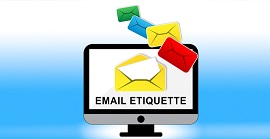
Email etiquette rules determine what is appropriate and what is not when sending an email message. Following some basic guidelines helps avoid miscommunications and blunders when sending a message. Email etiquette is not just important in business, but for personal email as well.
Email messages should be well written, clear, and precise.
Descriptive Subject Line
Use a descriptive subject line that gives the recipient a good idea of what the message is about but keep it brief.
Use a Professional Salutation
When addressing the recipient, it is acceptable to use Dear, Hi or Hello followed by the person’s name. Don’t shorten a person’s name unless you have been given permission or they always go by that name.
Clear and to the Point
The message should be clear and to the point, avoid writing a long, drawn-out email which wastes the recipient’s time.
Use an Introduction
Especially in business it is important to give a brief introduction when sending a message to someone new. Give your first and last name and business name in the first few lines of the message.
Use a Professional Tone
Be friendly and pleasant but avoid jokes which may not come across appropriately in an email message.
Make sure that the content is relevant to the addressee, nobody likes to receive unnecessary email.
Trim any quoted message down as much as possible.
Include a Signature
A signature can include your name and contact information. Keep the signature professional. You can create a signature in whichever email program you use and enable the option to automatically insert the signature when creating a new message. Most email programs allow you to have more than one signature if you have the need for that.
Note Any Attachments
If you are sending an email attachment point this out in the message. Tell the person what is included in the attachment. Email viruses and malware can be spread using attachments and the recipient should know you intended to send it.
Check Mail Regularly
Check your mail regularly and respond promptly if possible.
If you want to keep a message, respond to it and then file it in a folder. Delete email you no longer need. If your inbox and sent items folders are clean it keeps you organized. Avoid allowing email to pile up and empty your deleted items folder regularly.
Check Spelling and Grammar
Always check your spelling and grammar before sending a message. Email programs have an option to automatically spell and grammar check messages before sending so you don’t need to remember to do it each time. Be sure that option is turned on in the email program you are using.
Use Proper Punctuation
Use proper punctuation, avoid using too many exclamation points. They are meant to show excitement, emergency, emphasis, surprise, or strong emotion. However, the overuse of exclamation points feels sloppy and unprofessional. Also, avoid abbreviations like LOL, ROFL, etc. They do not translate well in business. And avoid using all caps.
Use BCC
Use BCC (Blind Carbon Copy) when addressing a message that will go to a group of people. When you send an e-mail message to a group of people and use To or CC to address the message, all the people in that message see each other’s e-mail address. By using BCC, each recipient sees only two, theirs and yours. Using BCC cuts down on spam.
Use Standard Formatting
It is best to use standard fonts and formatting, especially in business, cute backgrounds, emojis, pictures, quotes, etc. should be avoided.
Be Mindful of the Content
Never send an angry email or give a flippant response. Give your message some thoughtful reflection before sending it. If need be, put the message in your drafts folder and go back later and review it before sending, once it is sent you cannot take it back.
Be Confidential
Keep private material confidential. Be careful when forwarding or sharing an email message, the email may contain information that the sender does not want to share. If unsure contact the person and ask permission.
Be Aware of Privacy Issues
Remember that email is not as private as it may seem. Most email is not encrypted so avoid including anything highly confidential in an email message. Things like usernames and passwords, credit card information, Social Security number, banking or other financial information should not be included in a message. Gossip and derogatory remarks about another person should also be avoided.
Use Auto Reply in Business
Use an out of office reply if you will be away from the office and unable to respond to messages. Setup a rule in your mailbox that automatically send a message in response to the messages you receive while you are away. Let the recipient know that you are away and for how long and that you will respond to their message upon your return. If they need to be directed to someone else during your absence provide them with that information. Be sure to include a descriptive subject line such as “Out of Office” or “This is an automated message while I am away” so that the recipient can easily see they have received an automated response.
